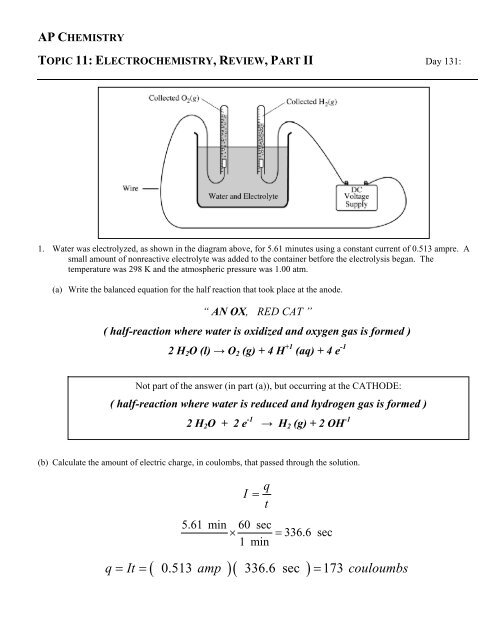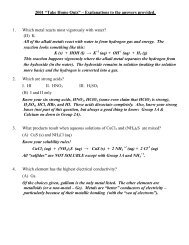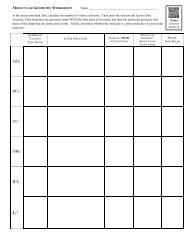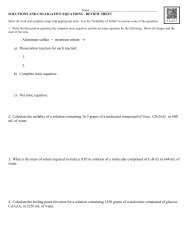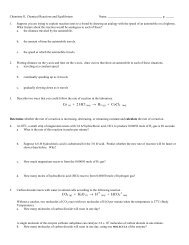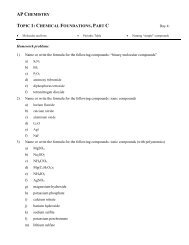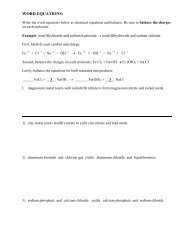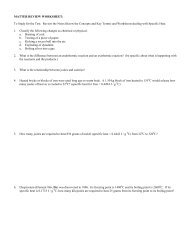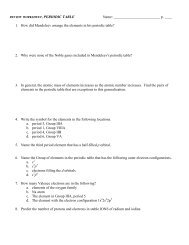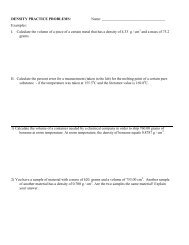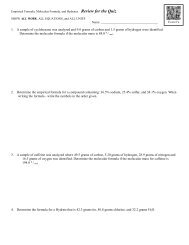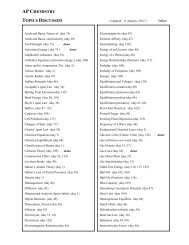You also want an ePaper? Increase the reach of your titles
YUMPU automatically turns print PDFs into web optimized ePapers that Google loves.
AP CHEMISTRY<br />
TOPIC 11: ELECTROCHEMISTRY, REVIEW, PART II Day 131:<br />
1. Water was electrolyzed, as shown in the diagram above, for 5.61 minutes using a constant current of 0.513 ampre. A<br />
small amount of nonreactive electrolyte was added to the container betfore the electrolysis began. The<br />
temperature was 298 K and the atmospheric pressure was 1.00 atm.<br />
(a) Write the balanced equation for the half reaction that took place at the anode.<br />
“ AN OX, RED CAT ”<br />
( half-reaction where water is oxidized and oxygen gas is formed )<br />
2 H 2 O (l) → O 2 (g) + 4 H +1 (aq) + 4 e -1<br />
Not part of the answer (in part (a)), but occurring at the CATHODE:<br />
( half-reaction where water is reduced and hydrogen gas is formed )<br />
2 H 2 O + 2 e -1 → H 2 (g) + 2 OH -1<br />
(b) Calculate the amount of electric charge, in coulombs, that passed through the solution.<br />
I =<br />
q<br />
t<br />
5.61 min 60 sec<br />
× = 336.6 sec<br />
1min<br />
( )( )<br />
q = It = 0.513 amp 336.6 sec = 173 couloumbs
(c) Why is the volume of O 2 (g) collected different from the volume of H 2 (g) collected, as shown in the diagram<br />
When water decomposes according to the balanced chemical equation<br />
2 H 2 O (l) → O 2 (g) + 2 H 2 (g)<br />
Twice as many moles of hydrogen are produced than moles of oxygen – recall, all gases (<br />
regardless of the mass of the molecule ) behave in the same way at the same temperature and<br />
pressure.<br />
(d) Calculate the number of moles of H 2 (g) produced during the electrolysis.<br />
The half-reaction that takes place at the cathode is:<br />
2 H 2 O (l) → O 2 (g) + 4 H +1 (aq) + 4 e -1<br />
2 ( 2 H 2 O (l) + 2 e -1 → H 2 (g) + 2 OH -1 (aq) )<br />
6 H 2 O → O 2 (g) + 4 H +1 (aq) + 2 H 2 (g) + 4 OH -1 (aq)<br />
(e) Calculate the volume, in liters, at 298 K and 1.00 atm of dry H 2 (g) produced during the electrolysis.<br />
“ dry H 2 (g) “ refers to only the hydrogen gas ( ignoring the water vapor usually included<br />
with the pressure of the gas BUBBLED through and COLLECTED OVER WATER )<br />
– you TYPICALLY calculate for a dry gas – nothing new…<br />
PV = nRT<br />
−4 ⎛0.0821<br />
Latm ⋅ ⎞<br />
( 8.96× 10 mol ) ( 298 K )<br />
nRT<br />
⎜ ⎟<br />
mol ⋅ K<br />
V = =<br />
⎝<br />
⎠<br />
= 0.0219<br />
P<br />
1 atm<br />
L
(f) After the hydrolysis reaction was over, the vertical position of the tube containing the collected H 2 (g) was<br />
adjusted until the water levels inside and outside the tube were the same, as shown in the diagram below. The<br />
volume of gas in the tube was measured under these conditions of 298 K and 1.00 atm, and its volume was<br />
greater than the volume calculated in part (e). Explain.<br />
Because the electrolysis of water occurs in water, there is some water vapor in the tube where<br />
hydrogen gas was collected. The volume calculated in part (e) was the volume of<br />
only the hydrogen gas in the tube at the given temperature and pressure. The<br />
presence of another gas ( water vapor ) results in greater volume at the given<br />
temperature and pressure.<br />
2. Calculate the standard free-energy change for the reaction shown below: ( Be sure to balance atoms and charges )<br />
Ba (s) + Cu +1 (aq) → Ba +2 (aq) + Cu (s)<br />
Ba → Ba +2 + 2 e -1 ( + 2.90 V)<br />
2 ( Cu +1 + e -1 → Cu ) ( + 0.52 V )<br />
YES !!!<br />
+ 3.42 V<br />
ΔG<br />
= −<br />
ΔG = - n I E 0<br />
⎛ 96,500 J ⎞<br />
⎜<br />
−<br />
V mol e ⎟<br />
⎝ ⋅ ⎠<br />
−<br />
5<br />
( 2 mol e ) ⎜ ⎟ ( + 3.42 V ) = −6.60<br />
× 10 J<br />
Negative ΔG = spontaneous
3. How long will it take to plate out 3.33 kg Sr from aqueous Sr +2 with a current of 12.0 amps<br />
Sr +2 + 2e -1 → Sr<br />
3.33<br />
−1<br />
kg Sr 1000 g Sr 1 mol Sr 2 mol e 96,500 coulombs<br />
7<br />
× × × ×<br />
= 7.335×<br />
10<br />
−1<br />
1.0 kg 87.62 g 1 mol Sr 1 mol e<br />
coulombs<br />
7<br />
q q 7.335×<br />
10 amps ⋅sec<br />
5<br />
I = ; t = =<br />
= 6.112 × 10 sec<br />
t I 12.0 amps<br />
6.112 × 10<br />
5<br />
sec 1 hour<br />
×<br />
3600 sec<br />
=<br />
170<br />
hour<br />
4. Using a current of 28.00 amps, it took 123.7 minutes to plate all of the iron from 555 mL of a solution containing Fe +2 .<br />
(a) Calculate the mass (in grams) of iron “plated out”, and (b) the original concentration of Fe +2 in the solution<br />
123.7 min 60 sec<br />
Fe +2 + 2 e -1 → Fe ; × = 7422 sec<br />
1 min<br />
q<br />
=<br />
It<br />
=<br />
5<br />
( 28 .00 amp) ( 7422 sec) = 2.078×<br />
10 couloumbs<br />
2.078×<br />
10<br />
5<br />
−1<br />
coulombs 1 mol e 1 mol Fe<br />
×<br />
×<br />
96,500 coulombs 2 mol e<br />
+ 2<br />
−1<br />
= 1.08<br />
mol<br />
(a)<br />
1.08<br />
mol 55.85 g<br />
1.08 mol<br />
× = 60.1 g ; (b) M = = 1. 94 M<br />
1 mol Fe<br />
0.555 L


